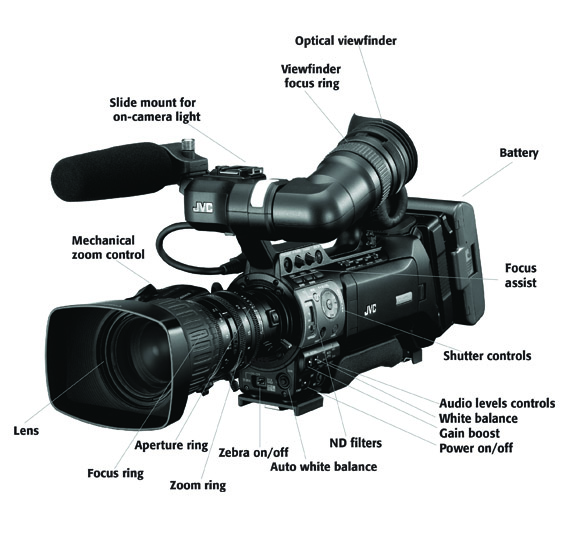
Professional ENG-style HD cameras like this one from JVC feature a timecode input for jam synching to other devices, such as a timecode slate in a multi-cam shoot.
From The Digital Filmmaking Handbook, 5th edition, Chapter 3
Video footage is almost always acquired by a camera (unless it is computer-generated), and every video camera records to a specific, usually proprietary, format. Because video cameras are constantly being updated and developed, acquisition formats change frequently. Also, some higher-end cameras can record more than one format.
Here is a list of popular video acquisition codecs:
- DVCPRO-HD is technically part of the DV family but employs a more complex DV encoding algorithm and higher bit rates (40–100Mbps) resulting in high-quality 4:2:2, 8-bit HD video.
- MPEG-IMX is a 4:2:2, 8-bit format that uses intraframe compression and records to optical discs or digital videotape. It is a popular ENG (electronic news gathering) format for TV, news, and so on.
- XDCAM HD from Sony is a 4:2:2, 8-bit direct-to-disc professional HD format that uses MPEG-2 compression to record to optical discs or memory cards.
- AVCHD is a tapeless MPEG-4-based HD format developed by Panasonic and Sony and aimed at consumer-grade HD cameras. It offers 4:2:0 8-bit color sampling, and it is used by several different types of cameras, including the Panasonic AVCCAM line and most DSLR cameras that shoot HD.
- AVC-Intra is a 4:2:0, 10-bit MPEG-4-based HD codec that comes in either a 100Mbps or 50Mbps format. Developed by Panasonic, this format is often used in conjunction with proprietary P2 cards.
- HDCAM is a 4:4:4, 10-bit HD codec used by the Sony professional family of videotape-based camcorders that uses proprietary DCT-based compression.
- Raw encoded media (REDCODE RAW, ARRIRAW, CinemaDNG RAW, etc.) results in high-quality digital cinema formats that have more or less replaced 35mm film, offering 2K, 3K, and 4K resolutions without any additional in-camera compression or image processing. (More on raw media in the next section.)
- Apple ProRes started out as an intermediate codec used for editing, but some cameras, such as the ARRI ALEXA and the Blackmagic Design cameras, can shoot with this codec as well.
- Avid DNxHD, like Apple ProRes, started out as an intermediate codec used for editing, but some cameras, like those from Blackmagic Design, can shoot with this codec as well.

